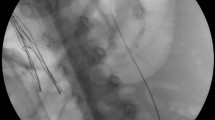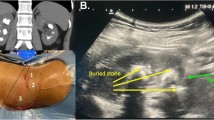Abstract
Purpose
The ultrasound-guided (US) puncture in percutaneous nephrolithotomy (PCNL) has demonstrated advantages over traditional fluoroscopy access. The aim of this study was to demonstrate the reduction of fluoroscopy time using this technique during PCNL as the surgeon gained experience.
Methods
Transversal study performed on 30 consecutive patients undergoing PCNL from March to November 2019. All punctures were performed with US guidance. The patients were divided into 2 groups of 15 each according to the chronological order of the intervention. Demographic data, preoperative parameters, puncture time, fluoroscopy time, stone-free rate and complications were analyzed.
Results
The time of fluoroscopy was considerably reduced as the experience in the number of cases increased, reducing from 83.09 ± 47.8 s in group 1 to 22.8 ± 10.3 s in group 2 (p < 0.01), the time required to perform the puncture was reduced of 108.1 ± 68.9 s in group 1, to 92.6 ± 94.7 s in group 2 (p < 0.67). Stone free rate of 83.3% was obtained globally.
Conclusion
US percutaneous renal access is safe and reproducible technique; the main advantage is to reduce exposure to radiation without compromising clinical results and has a short learning curve for urologists with prior experience in PCNL.


Similar content being viewed by others
References
Patel SR, Nakada SY (2015) The modern history and evolution of percutaneous nephrolithotomy. J Endourol 29:153–157. https://doi.org/10.1089/end.2014.0287
Türk C, Neisius A, Petřík A et al (2020) EAU guidelines on urolithiasis 2020. Eur Assoc Urol Guidel 2020 Ed presented
Iordache A, Baston C, Silviu-Stelian G-M et al (2018) Ultrasound for kidney access in percutaneous nephrolithotomy: a contemporary review. Med Ultrason 20:508. https://doi.org/10.11152/mu-1618
Usawachintachit M, Masic S, Allen IE et al (2016) Adopting ultrasound guidance for prone percutaneous nephrolithotomy: evaluating the learning curve for the experienced surgeon. J Endourol 30:856–863. https://doi.org/10.1089/end.2016.0241
Wenzl TB (2005) Increased brain cancer risk in physicians with high radiation exposure. Radiology 235:709–711. https://doi.org/10.1148/radiol.2352041787
Linet MS, Freedman DM, Mohan AK et al (2005) Incidence of haematopoietic malignancies in US radiologic technologists. Occup Environ Med 62:861–867. https://doi.org/10.1136/oem.2005.020826
Ng FC, Yam WL, Lim TYB et al (2017) Ultrasound-guided percutaneous nephrolithotomy: advantages and limitations. Investig Clin Urol 58:346–352. https://doi.org/10.4111/icu.2017.58.5.346
Chu C, Masic S, Usawachintachit M et al (2016) Ultrasound-guided renal access for percutaneous nephrolithotomy: a description of three novel ultrasound-guided needle techniques. J Endourol 30:153–158. https://doi.org/10.1089/end.2015.0185
Inoue T, Okada S, Hamamoto S et al (2018) Current trends and pitfalls in endoscopic treatment of urolithiasis. Int J Urol 25:121–133. https://doi.org/10.1111/iju.13491
Alcaraz-Gutiérrez M, Pulido-Contreras E, García-Padilla MA et al (2018) Experience of the first fifty percutaneous nephrolithotomies performed at a Mexican medical center. Rev Mex Urol 78:28–33. https://doi.org/10.24245/revmexurol.v78i1.1630
Andonian S, Scoffone CM, Louie MK et al (2013) does imaging modality used for percutaneous renal access make a difference? A matched case analysis. J Endourol 27:24–28. https://doi.org/10.1089/end.2012.0347
Simmons J, Fulgham PF (2013) Renal ultrasound. In: Fulgham PF, Gilbert BR (eds) Practical urological ultrasound. Springer, New York, pp 47–69
Desai M (2009) Ultrasonography-guided punctures—with and without puncture guide. J Endourol 23:1641–1643. https://doi.org/10.1089/end.2009.1530
Gupta S, Gulati M, Suri S (1998) Ultrasound-guided percutaneous nephrostomy in non-dilated pelvicaliceal system. J Clin Ultrasound 26:177–179. https://doi.org/10.1002/(SICI)1097-0096(199803/04)26:3%3c177::AID-JCU13%3e3.0.CO;2-8
Häcker A, Wendt-Nordahl G, Honeck P et al (2007) A biological model to teach percutaneous nephrolithotomy technique with ultrasound- and fluoroscopy-guided access. J Endourol 21:545–550. https://doi.org/10.1089/end.2006.0327
Bayne DB, Usawachintachit M, Tzou D et al (2018) Increasing body mass index steepens the learning curve for ultrasound-guided percutaneous nephrolithotomy. Urology 120:68–73. https://doi.org/10.1016/j.urology.2018.07.033
Song Y, Ma YN, Song YS, Fei X (2015) Evaluating the learning curve for percutaneous nephrolithotomy under total ultrasound guidance. PLoS ONE. https://doi.org/10.1371/journal.pone.0132986
Allen D, O’Brien T, Tiptaft R, Glass J (2005) Defining the learning curve for percutaneous nephrolithotomy. J Endourol 19:279–282. https://doi.org/10.1089/end.2005.19.279
Liu Q, Zhou L, Cai X et al (2017) Fluoroscopy versus ultrasound for image guidance during percutaneous nephrolithotomy: a systematic review and meta-analysis. Urolithiasis 45:481–487. https://doi.org/10.1007/s00240-016-0934-1
Inanloo SH, Yahyazadeh SR, Rashidi S et al (2018) Feasibility and safety of ultrasonography guidance and flank position during percutaneous nephrolithotomy. J Urol 200:195–201. https://doi.org/10.1016/j.juro.2018.02.074
Falahatkar S, Neiroomand H, Enshaei A et al (2010) Totally ultrasound versus fluoroscopically guided complete supine percutaneous nephrolithotripsy: a first report. J Endourol 24:1421–1426. https://doi.org/10.1089/end.2009.0407
Li JX, Xiao B, Hu WG et al (2014) Complication and safety of ultrasound guided percutaneous nephrolithotomy in 8 025 cases in China. Chin Med J 127:4184–4189. https://doi.org/10.3760/cma.j.issn.0366-6999.20141447
Funding
The authors received no specific funding for this work.
Author information
Authors and Affiliations
Contributions
EP-C: protocol development, project development, data collection, manuscript writing, and manuscript editing. MAG-P: project development, manuscript writing, and manuscript editing. JM-S: project development and manuscript writing. MGL-V: data analysis and table design. MAP-R: data collection. RLS: project development and critical revision of the manuscript.
Corresponding author
Ethics declarations
Conflict of interest
On the part of the authors, no conflict of interest are declared.
Ethical approval
This study was conducted collecting data obtained for clinical purposes and all the procedures were performed as part of the routine care. Then, our study did not need ethical approval. The procedures used in this study adhere to the principles of the Declaration of Helsinki.
Informed consent
Informed consent was obtained from all individual participants included in the study prior to the procedures.
Additional information
Publisher's Note
Springer Nature remains neutral with regard to jurisdictional claims in published maps and institutional affiliations.
Rights and permissions
About this article
Cite this article
Pulido-Contreras, E., Garcia-Padilla, M.A., Medrano-Sanchez, J. et al. Percutaneous nephrolithotomy with ultrasound-assisted puncture: does the technique reduce dependence on fluoroscopic ionizing radiation?. World J Urol 39, 3579–3585 (2021). https://doi.org/10.1007/s00345-021-03636-2
Received:
Accepted:
Published:
Issue Date:
DOI: https://doi.org/10.1007/s00345-021-03636-2




